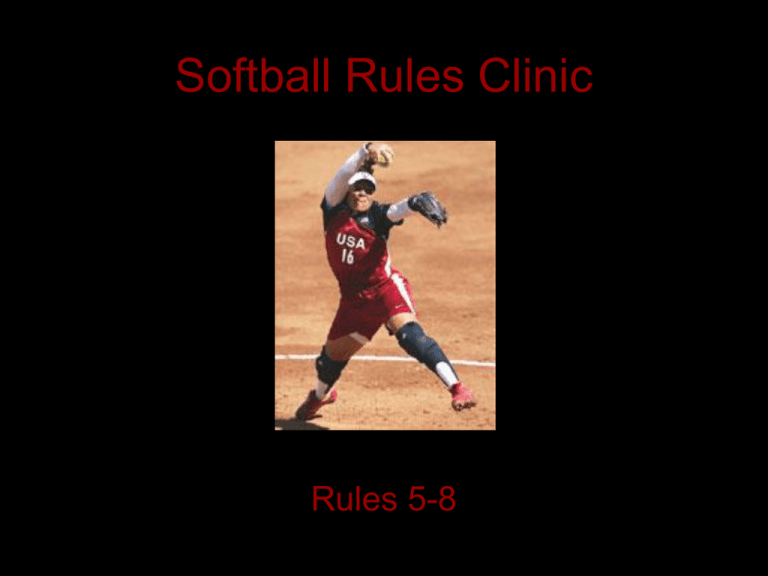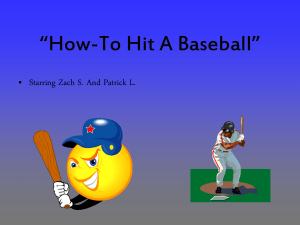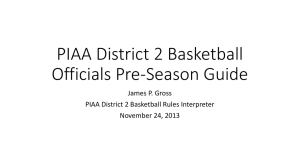Softball Rules Clinic
advertisement

Softball Rules Clinic Rules 5-8 Rule 5 Dead Ball and Suspension of Play • Dead Ball Tables Rule Book pp.43-44 • Situation • With two strikes on B3, B3 swings and misses a pitch. The ball strikes her arm or person. Ruling • This is a dead-ball strike and B3 is out. Situation • B1 hits a ground ball to left field. F7 throws the ball to the infield where it hits the umpire or base runner. Is the ball dead? Ruling • No. The ball remains alive if it hits the umpire or the base runner unless the base runner intentionally caused contact with the ball. Situation • A ball throw wildly to third base touches a photographer who is standing (a) inside or (b) outside the designated media area. Ruling • In (a) the ball is dead immediately. In (b) the ball remains alive. The photographer shall be instructed to stay in the designated media area. Delayed Dead Ball • The term applies to situations in which an infraction is not to be ignored and, therefore, the umpire, at the end of playing action, declares the ball dead for the purpose of making an award or imposing a penalty. These situations include: Illegal pitch (after the time of pitch); batter being obstructed; ball being touched with detached player equipment or an illegal glove; and runner being obstructed; and when a plate umpire interferes with the catcher who attempts to make a play on a runner. Situation • With R1 attempting to steal, the umpire interferes with the catcher’s throw. Ruling • The umpire signals delayed dead ball. If R1 is not put out, the umpire then declares the ball dead and R1 must return to the base occupied before the interference. Situation • After F1 has started delivery, B1 steps out of the batter’s box without requesting time. Ruling • If the pitcher delivers a legal pitch it shall be called a strike. If the pitcher stops or hesitates in her delivery, the umpire shall call “Time,” declare a “no pitch” and start play anew because both batter and pitcher violated a rule. Rule 6 Pitching • 6-2-2; 6-4-5 Clarified that powered resin or any comparable drying agent is permitted. • 6-5 New moved ball-rotation procedure from 41-4 to new 6-5. Points of Emphasis Leap • A “leap” is when both feet are airborne by the pitcher prior to releasing the ball. The pivot foot must stay in contact with the ground as it drags away from the pitching plate until the lead foot touches the ground. If both feet are off the ground at the same time during delivery, this is a “leap” and an illegal pitch shall be called by the base umpire. Crow Hop • A “crow hop” is defined as a re-plant of the pivot foot prior to releasing the ball. This can be done by sliding the foot in front of the pitching plate, lifting the pivot foot and stepping forward, and/or jumping forward with the pivot foot off the pitching plate prior to starting the pitch. To help determine whether the pitcher has replanted her pivot foot, the umpire should look at the location of the pivot foot when the hands separate to start the pitch. If the pivot foot is off and in front of the pitching plate before the hands separate to start the pitch, this would be a “crow hop” and an illegal pitch called by the base umpire. Situation • With R1 on second, R2 on first and one out, F1 fails to bring the hands together for one second, then delivers the pitch to B3 who hits into a double play. Ruling • Illegal pitch. The hands must come together for not less than one second. The hands do not have to remain motionless after coming together. The coach of the team at bat has the option of the play or the award. If the award is taken, all runners advance one base and a ball is called on the batter. Situation • After assuming a legal pitching position, F1 takes one hand off the ball and then steps backward off the pitcher’s plate. Ruling • Illegal pitch. The pitch starts when F1 takes one hand off the ball. Once the hands are separated, the only step F1 may take must be toward the batter. Situation • While the umpire is reporting a substitute to the official scorer, a pitcher continues to throw in excess of her five warm-up pitches. Ruling • Legal. The restriction of five warm-up pitches does not apply when the umpire delays the game due to substitutions, conferences, injuries, or other administrative duties. Rule 7 Batting • A batter shall not delay the game by failing to promptly take position in the batter’s box within 10 seconds after the ball is returned to the pitcher to prepare for the next pitch, or by stepping out of the box when the pitcher is on the pitcher’s plate. Penalty • If the pitcher has brought the hands together, the batter leaves the box at the risk of having a strike called while being out of position. For failure of the batter to be ready within 10 seconds after the ball has been returned to the pitcher, the umpire shall call a strike. If it is the third strike, the umpire shall call time and declare the batter out. Situation • With R1 on first, B8 erroneously bats in place of B7. The error is discovered by the opposing team (a) after B8 has received two strikes or (b) or after B8 has received a base on balls or is hit by a pitch, or (c) after B8 has hit a foul ball that is caught or has hit safely to advance R1 or (d) after a pitch has been delivered to B9. Ruling • In (a) B7 takes the place of B8 at the plate with a two strike, no ball count. If R1 has advanced by stealing or by a wild pitch while the wrong batter is batting, it is a legal advance. In (b) and (c) B7 is out. B8 is removed from the base and bats again with no balls or strikes. R1 shall return to the base occupied at the time of the pitch. In (d) no correction is made and B7 and B8 do not bat again until their regular time. Situation • B1 bats out of order and reaches first base. F1 then steps onto the pitcher’s plate and (a) drops the ball or (b) commits an illegal pitch. The defense then discovers that B1 has batted out of order. Ruling • In (a), until one hand is taken off the ball or F1 makes any motion that is part of a windup after the hands have been brought together, F1 is not considered to have started a pitch. Therefore the defense may appeal the batting out of order. In (b) the defense would not be allowed to appeal batting out of order because the infraction was not discovered prior to the next pitch (legal or illegal). Situation • B1 starts to swing at a pitch but attempts to hold back, or it appears as though it is an attempt to bunt the ball. In either case B1 misses the ball. How does the umpire determine what to call the pitch? Ruling • A call of this nature is based entirely upon the umpire’s judgment. Therefore the umpire shall, in order to be consistent, have guidelines to follow. Normally there are four areas that constitute whether or not the batter has swung at the ball or checked their swing: (1) rolling the wrist, (2) swinging through the ball and bringing or drawing the bat back, unless drawing it back occurs before the pitch gets to the bat, (3) the bat being out in front of the body, or (4) the batter makes an attempt to hit the pitch. In bunting any movement of the bat toward the ball when the ball is over or near the plate area, or holding the bat in the strike zone, is a strike. The bat must be withdrawn in order to take a pitch. Situation • As F1 starts her pitch, B1 request time by either stepping out of the box or by putting her hands up. The pitcher (a) hesitates or stops or stops her pitch or (b) legally delivers the ball. Ruling • In (a) the umpire shall declare a “no” pitch” and in (b) the umpire shall call a strike. Situation • With R1 on first, B2 has two strikes. B2 strikes at the next pitch which touches her. R1 steals second. Ruling • This is a dead-ball strike and B2 is out. R1 must return to first. Situation • With less than two outs, R1 on second and B2 at the plate,R1 attempts to steal third. In the process, B2 does not swing or does swing and (a) makes no attempt to get out of the way of the catcher throwing to third or (b) is unable to make an attempt to get out of the way of the catcher throwing to third. As a result, F2 is unable to make a play on the runner. Ruling • B2 is not guilty of interference in (a) or (b) . B2 is entitled to her position in the batter’s box and is not subject to interference unless she moves or re-establishes her position after F2 has received the pitch, which then prevents F2 from attempting to play on a runner. Failing to move so that a catcher can throw a ball is not batter interference. Situation • R1 is on third base and R2 is on first. B3 is at bat with (a) a 2-1 count or (b) a 2-2 count. F1 delivers an outside pitch as R2 attempts to steal second. B3 swings and misses the pitch which is caught by F2. After the pitch is caught, B3 momentum carries her across the plate and interferes with F2’s throw to second base. Ruling • Batter interference in (a), B3 is out and R2 must return to first base. R1 remains at third base. In (b) this is interference by a retired runner. R-1 is out (closest to home) and R2 must return to first base. Situation • With R1 on first, B2 who has two strikes, swings at the next pitch. F2 drops the ball and fails to throw to F3 at first. There are (a) no outs or (b) two outs. Ruling • In (a) B2 is out. In (b) B2 is safe at first if she reaches before being tagged out or thrown out. Situation • B1 swings and (a) hits the ball which strikes home plate and bounces up hitting the bat while the batter is in the batter’s box; (b) after laying down the bat and running to first, the ball hits the bat in fair territory; or (c) while advancing to first, drops the bat in fair territory and the bat, while still moving, hits the ball. Ruling • A foul ball in (a). The ball remains alive in (b). In (c) the batter is out and the ball is dead. Situation • In hitting a slow roller to F5, the (a) whole bat slips out of B1’s hands and interferes with F5 or (b) her bat breaks and hits the ball or F5 as F5 attempts to field the ball. Ruling • In (a) the ball is dead immediately. B1 is declared out for interference, because B1 is responsible for controlling her bat and not allow it to interfere with a defensive player making a play. In (b) there is no penalty and the ball remains alive. Rule 8 Batter- Runner and Runner • 8-6-18 Changed that intent need not be the determining factor in ruling whether interference has occurred by a runner who has scored/been retired. 8.6.18 8.6.18 SITUATION SITUATION With R1 on first base and one out, B3 is at the plate with a 3-2 count. The pitch is swung at and missed. F2 drops the ball and B3 runs to first base even though first base is occupied. F2 throws the ball to first in an attempt to pick off R1, who is diving back to first base. The ball hits B3 in the back and ricochets into the dugout. RULING: With first base occupied and less than two outs, B3 is out on strike three. Therefore, she has interfered with F2’s throw to first base. The ball is dead and R1 (the runner closest to home) is ruled out for the third out. Situation • With two outs, the bases loaded and a 3-2 count on B6, the next pitch is a wild pitch. R1 begins advancing to home. R2, on second base is off with the pitch. She rounds third base, but is caught off the base by an excellent throw by F2 for the third out. R1 had not touched home when R2 was tagged out at third. Ruling • R1 was rewarded home as soon as ball four was declared. Consequently, as soon as R1 touches the plate, her run counts. Situation • R1 is on second with one out. F2 obstructs B3 with who hits a ground ball to F4. F4 throws B3 out. F3 overthrows to third in an attempt to retire R1 who scores on the overthrow. Ruling • The coach of the team at bat may elect to take the result of the play scoring R1, or she may accept the catcher’s obstruction penalty, placing R1 back on second and B3 back on first. Situation • A pitched ball touches the ground in front of home plate and then hits B1. Ruling • B1 is entitled to first base unless no effort was made to avoid being hit. Situation • With the bases loaded, B4 who bats left handed, hits a ground ball to F3, who is left handed. The ball is just inside the foul line. F3 throws to F2, but hits B4, who is on her way to first base. B4 is in fair territory, but has not reached the 30-foot running lane. Ruling • There is no violation, unless the batterrunner intentionally interfered with F3’s throw. Situation • With R1 on third base, R2 on first and two outs, B5 hits a fair slow roller toward first base. B5 interferes with F3, who is trying to field the ball. However, R1 scores before the interference. Does the run score since R1 touched home plate before the interference. Ruling • The run does not score if any runner advanced during action which the third out was made by the batter-runner before she touched first base. Situation • With R1 on second, B2 bunts the ball down the first-base line. F3 fields and the ball and runs toward B2. B2, in an effort to buy time for R1, backtracks toward home. Ruling • B2 is out. B2 is permitted to stop between first base and home plate. Once B2 retreats, she is out. The ball is dead immediately. R1 must return to second base, the last base she had touched at the time of the infraction. Situation • B1 hits a slow roller to F5 and arrives safely but misses first base. F3 catches the ball while standing on first base after B1 has beaten the throw. Ruling • If the runner passes first base before the throw arrives, she is considered to have touched the base unless an appeal play is made.F3 must tell the umpire she is appealing B1 missing first base before she returns to the base. Situation • R1 is on first when B2 hits a fly ball to right field. R1 goes half way and F9 makes a diving catch. F9 then throws to F3, but throws the ball into the stands before R1 can retouch. Does R1 have to retouch first base before being awarded third? Ruling • Yes, because R1 left the base before F9 touched the ball. This is an appeal play and the umpire can only rule on R1 touching first base when the defense appeals the play. Situation • With R1 on first, B2 hits a ground ball to F3 who (a) steps on first and then tags R1 who remained on first, or (b) tags R1 while R1 is on first and then steps on first. Ruling • In (a) R1 is not out since the force was removed when B2 was put out. In (b) both R1 and B2 are out. Situation • R1 is on first when B2 hits a line drive that bounds off F4’s glove to F8 who catches it. R1 leaves first after F4 touched the ball but before the catch. Ruling • This is a legal advance by R1. B2 is out. Situation • With one out and R1 on third, B3 flies to F7 for the second out. R1 scores after the catch, but the umpire observes that R1 left before the catch. Ruling • The umpire must wait for the defensive team to make an appeal before calling R1 out. Situation • With no outs, B1’s third strike is missed by F2 and the ball lodges between her body and chest protector. While F1 hunts the ball, B1 continues to second. Ruling • The ball remains live and B1 is entitled to advance since the third strike was not caught. Situation • With R1 on first base, B2 hits a pitch with one foot completely outside the batter’s box. F6 fields the ball. F4 obstructs R1 advancing to second base. Ruling • The ball became dead at the time of B2’s violation. B2 is out and R1 must return to first base. Situation • F2, without the ball is blocking home plate. R1 pushes F2, but not flagrantly, out of the base path and touches home plate. Ruling • The umpire would call obstruction and signal a delayed ball. Since the runner reached home safely there would be no award given. Situation • R1 is on second base. A fielder then throws her glove which hits (a) a batted ball over fair ground, preventing the ball from going over the center field fence in flight; or (b) a fair batted ball preventing it from bouncing over the fence. Ruling • The award is from the base occupied at the time of the pitch. The number of bases awarded is four in (a) and three in (b). Situation • On a hit-and-run signal, R1 has reached and passed second before the ball batted by B2 bounces over or throughthe fence in right field. Ruling • In this situation, the awards are made from the time of the pitch. B2 and R1 are awarded two bases. R1 will end up on third and B1 will get second base. Situation • With the bases loaded and one out, B5 hits a ground ball toward F6. The batted ball hits R2 and prevents F6 from making a play. May two runners be called out and does the run score? Ruling • The run does not score since each runner must return to the base occupied at the time of the interference. R2 is out and B5 is awarded first base. Situation • With R1 on third base and R2 on first base, F1 double touches for an illegal pitch. The plate umpire calls an illegal pitch but before the hands separate to deliver the ball, R2 leaves first base on her way to second base. The base umpire calls “dead ball” and calls R2 out. Ruling • R2 is out for leaving first base before F1 released the ball. The illegal pitch is enforced which results in a “ball” being awarded to B3 and one base (home) to R1. Situation • R1 is on third base when B2 receives ball four. R1 comes off the base with the pitch. The catcher throws the ball directly back to the pitcher in the 16-foot circle. Can R1 remain off third base until B2 reaches first? Ruling • Yes. The look-back rule does not go into effect until the batter-runner has reached first base and the pitcher has possession of the ball in the 16-foot circle. At that time, all runners on base must immediately move forward or return to their base. Situation • Smith is a courtesy runner for the catcher in the first inning. She then courtesy runs for the pitcher in the sixth. Ruling • Illegal. The same player cannot be a courtesy runner for both positions in the same game. The illegal substitute is declared out and restricted to the dugout/bench for the rest of the game. Situation • No. 11 has served as the courtesy runner for the pitcher for several innings. In the seventh inning, the pitcher hits for a single. No. 11 courtesy runs for the pitcher. After No. 11 safely reaches third base, the head coach requests that substitute, S1, who has not previously been in the game, replace No. 11 (courtesy runner). Ruling • An eligible substitute may enter the game to “pinch run” for the courtesy runner. In this situation, S1, the pinch runner, is entering the game in the pitcher’s position in the batting order; the pitcher has left the game. Situation • With R1 on first base, B2 hits a fair ball to F8. B2 in rounding the double first base (a) touches the colored part and continues to second, (b) touches the white part and continues to second, (c) cannot make it safely to second and returns to first, touching the colored portion of the base. Ruling • Legal in (a), (b), and (c) . In (b) B2 is allowed to touch the white part of the base since there is no play being made on her and provided she does not interfere with the fielder at first base. In (c) B2 may touch either the white or colored portion when returning to first base.








